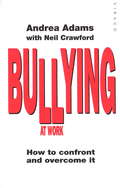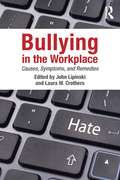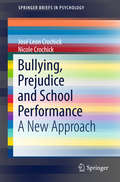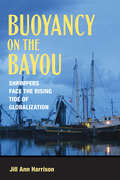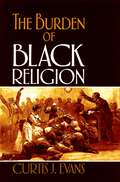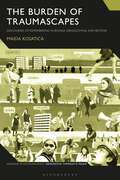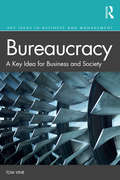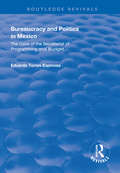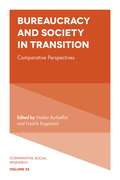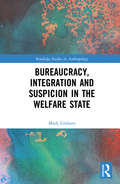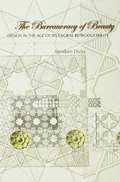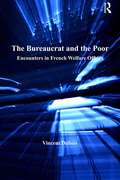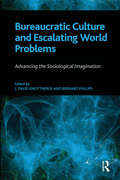- Table View
- List View
Bullying At Work: How to Confront and Overcome It
by Andrea AdamsThrough personal accounts and revelations, this book explores bullying at work and offers solutions to help overcome this stressful, often isolating experience facing many women and men. Based on three years of research, Andrea Adams plots the destructive forces currently eroding the professional lives of many people. By tracing the psychological origins of bullying at work this book investigates the effect of past relationships on the present, providing both individuals and organizations with a deeper understanding of why things can go so badly wrong. Through advice and guidance, it offers a way forward for all those who value the need for psychological well-being at the workplace.
Bullying in the Workplace: Causes, Symptoms, and Remedies (Applied Psychology Series)
by John Lipinski Laura M. CrothersBullying in the workplace is a phenomenon that has recently intrigued researchers studying management and organizational issues, leading to such questions as why it occurs and what causes such harassment. This volume written by experts in a wide range of fields including Industrial and Organizational psychology, Counseling, Management, Law, Education and Health presents research on relational and social aggression issues which can result in lost productivity , employee turnover and costly lawsuits. Understanding this phenomenon is important to managers and employee morale.
Bullying in the Workplace: Causes, Symptoms, and Remedies (Applied Psychology Series)
by John Lipinski Laura M. CrothersBullying in the workplace is a phenomenon that has recently intrigued researchers studying management and organizational issues, leading to such questions as why it occurs and what causes such harassment. This volume written by experts in a wide range of fields including Industrial and Organizational psychology, Counseling, Management, Law, Education and Health presents research on relational and social aggression issues which can result in lost productivity , employee turnover and costly lawsuits. Understanding this phenomenon is important to managers and employee morale.
Bullying, Prejudice and School Performance: A New Approach (SpringerBriefs in Psychology)
by José Leon Crochick Nicole CrochickThis brief presents a new approach to the study of bullying and prejudice in school settings, analyzing the particularities of these two forms of violence and relating them to the hierarchies that distinguish students based on academic performance and popularity. Analyzing data gathered by surveys carried out between 2010 and 2014 with 274 students from public schools of São Paulo, Brazil, the authors show that, despite bullying and prejudice are related, they have specific characteristics that need to be acknowledged in order to help educators develop more efficient initiatives to prevent them. Building upon the Critical Theory of Society – especially Adorno’s studies of authoritarian personality and school hierarchies – the authors develop a theoretical framework that helps researchers and educators to identify the particularities of bullying and prejudice and develop specific strategies to deal with them. In addition, the empirical and theoretical elements presented in the book show how these forms of violence are related to the two hierarchies that exist side by side in schools – the official hierarchy that distinguishes good and bad students based on their academic performance and the unofficial hierarchy characterized by the distinction between those who excel in dating, fighting, in team sports and those who do not excel in any of these activities. This innovative volume:• Argues that bullying and prejudice are different forms of school violence that demand different theoretical and practical approaches• Examines data gathered by surveys carried out with 274 students of public schools in São Paulo, Brazil, between 2010 and 2014 • Relates bullying and prejudice to the hierarchies that distinguish students based both on their academic performance and popularity• Analyzes the impact of factors such as autonomy from the school authority and the ideology of authoritarianism on bullying and prejudice• Presents strategies to fight bullying and prejudice in schoolsBullying, Prejudice and School Performance: A New Approach is a useful and innovative tool for psychologists, educators, sociologists, school teachers and researchers in the fields of child and school psychology, educational psychology, sociology of education and related disciplines.
Bundeswehr und Gesellschaft - Wahrnehmungen im Wandel (Militär und Sozialwissenschaften/The Military and Social Research #57)
by Martin Elbe Angelika Dörfler-DierkenDas Buch erscheint als Band 57 der Reihe Militär und Sozialwissenschaften/The Military and Social Research, herausgegeben von Martin Elbe und Angelika Dörfler-Dierken im Auftrag des Arbeitskreises Militär und Sozialwissenschaften (AMS). Anlässlich des 50. Jahrestages des AMS fand eine Tagung in Kiel zum Thema „Bundeswehr und Gesellschaft – Wahrnehmungen im Wandel" statt. Das vorliegende Buch fasst die dort vorgestellten Beiträge zum Thema zusammen und ergänzt diese um ausgewählte Beiträge. Das Thema wird von zahlreichen Professorinnen und Professoren, Praktikern aus dem BMVg und von Forschenden aus unterschiedlichen Forschungseinrichtungen beleuchtet sowie von der Wehrbeauftragten des Deutschen Bundestages kommentiert. Wandlungspotenziale und -bedarfe werden ebenso deutlich wie Kontinuitätsmuster.
Bündnisse für Wohnen im Quartier: Ein Format integrierter und kooperativer Quartiersentwicklung (Quartiersforschung)
by Svenja GrzesiokBündnisse für Wohnen gelten auf bundes-, landes- und kommunalpolitischer Ebene als neue Governance-Formen, um Lösungen für aktuelle wohnungspolitische Herausforderungen zu entwickeln und zugleich privatwirtschaftliches und zivilgesellschaftliches Engagement in den Prozess einzubinden. Svenja Grzesiok geht der Frage nach, welche Bedeutung diese neue Form von Governance bei der Quartiersentwicklung einnehmen kann. Sie analysiert Ausprägung und Potenziale solcher Bündnisse im Rahmen integrierter Quartiersentwicklung und beleuchtet die Ziele, Strategien und Handlungslogiken der Akteure im Handlungsfeld Wohnen. Anhand dreier Fallstudien werden die Wirkungen auf die integrierte Quartiersentwicklung untersucht.
Buoyancy on the Bayou: Shrimpers Face the Rising Tide of Globalization
by Jill Ann. HarrisonOver the past several decades, shrimp has transformed from a luxury food to a kitchen staple. While shrimp-loving consumers have benefited from the lower cost of shrimp, domestic shrimp fishers have suffered, particularly in Louisiana. Most of the shrimp that we eat today is imported from shrimp farms in China, Vietnam, and Thailand. The flood of imported shrimp has sent dockside prices plummeting, and rising fuel costs have destroyed the profit margin for shrimp fishing as a domestic industry.In Buoyancy on the Bayou, Jill Ann Harrison portrays the struggles that Louisiana shrimp fishers endure to remain afloat in an industry beset by globalization. Her in-depth interviews with more than fifty individuals working in or associated with shrimp fishing in a small town in Louisiana offer a portrait of shrimp fishers' lives just before the BP oil spill in 2010, which helps us better understand what has happened since the Deepwater Horizon disaster.Harrison shows that shrimp fishers go through a careful calculation of noneconomic costs and benefits as they grapple to figure out what their next move will be. Many willingly forgo opportunities in other industries to fulfill what they perceive as their cultural calling. Others reluctantly leave fishing behind for more lucrative work, but they mourn the loss of a livelihood upon which community and family structures are built. In this gripping account of the struggle to survive amid the waves of globalization, Harrison focuses her analysis at the intersection of livelihood, family, and community and casts a bright light upon the cultural importance of the work that we do.
The Burden of Black Religion
by Curtis J. EvansReligion has always been a focal element in the long and tortured history of American ideas about race. In The Burden of Black Religion, Curtis Evans traces ideas about African American religion from the antebellum period to the middle of the twentieth century. Central to the story, he argues, was the deep-rooted notion that blacks were somehow "naturally" religious. At first, this assumed natural impulse toward religion served as a signal trait of black people's humanity -- potentially their unique contribution to American culture. Abolitionists seized on this point, linking black religion to the black capacity for freedom. Soon, however, these first halting steps toward a multiracial democracy were reversed. As Americans began to value reason, rationality, and science over religious piety, the idea of an innate black religiosity was used to justify preserving the inequalities of the status quo. Later, social scientists -- both black and white -- sought to reverse the damage caused by these racist ideas and in the process proved that blacks were in fact fully capable of incorporation into white American culture. This important work reveals how interpretations of black religion played a crucial role in shaping broader views of African Americans and had real consequences in their lives. In the process, Evans offers an intellectual and cultural history of race in a crucial period of American history.
The Burden of Black Religion
by Curtis J. EvansReligion has always been a focal element in the long and tortured history of American ideas about race. In The Burden of Black Religion, Curtis Evans traces ideas about African American religion from the antebellum period to the middle of the twentieth century. Central to the story, he argues, was the deep-rooted notion that blacks were somehow "naturally" religious. At first, this assumed natural impulse toward religion served as a signal trait of black people's humanity -- potentially their unique contribution to American culture. Abolitionists seized on this point, linking black religion to the black capacity for freedom. Soon, however, these first halting steps toward a multiracial democracy were reversed. As Americans began to value reason, rationality, and science over religious piety, the idea of an innate black religiosity was used to justify preserving the inequalities of the status quo. Later, social scientists -- both black and white -- sought to reverse the damage caused by these racist ideas and in the process proved that blacks were in fact fully capable of incorporation into white American culture. This important work reveals how interpretations of black religion played a crucial role in shaping broader views of African Americans and had real consequences in their lives. In the process, Evans offers an intellectual and cultural history of race in a crucial period of American history.
The Burden of Traumascapes: Discourses of Remembering in Bosnia-Herzegovina and Beyond (Advances in Sociolinguistics)
by Maida KosaticaDemonstrating the range of linguistic and semiotic practices which are deployed in the construction of war memory, The Burden of Traumascapes investigates the discourses of remembering that are enculturated in the everyday lives of the people of Bosnia-Herzegovina. Maida Kosatica explores how the memory and narratives of the Bosnian War (1992-5) convey and renegotiate historical acts of violence in quite ordinary, banal ways and extend the war into the present day. Reintroducing the concept of 'traumascapes', this book demonstrates that semiotic landscapes are marked by traumatic legacies of violence in which the sense of trauma establishes its meaning through the discourses of remembering. In this context, this book argues that discourses of remembering, whether constructed in physical or virtual spaces, stem simultaneously from personal and collective needs to follow moral orders and responsibility, as well as from political, pedagogical and economic demands.
The Burden of Traumascapes: Discourses of Remembering in Bosnia-Herzegovina and Beyond (Advances in Sociolinguistics)
by Maida KosaticaDemonstrating the range of linguistic and semiotic practices which are deployed in the construction of war memory, The Burden of Traumascapes investigates the discourses of remembering that are enculturated in the everyday lives of the people of Bosnia-Herzegovina. Maida Kosatica explores how the memory and narratives of the Bosnian War (1992-5) convey and renegotiate historical acts of violence in quite ordinary, banal ways and extend the war into the present day. Reintroducing the concept of 'traumascapes', this book demonstrates that semiotic landscapes are marked by traumatic legacies of violence in which the sense of trauma establishes its meaning through the discourses of remembering. In this context, this book argues that discourses of remembering, whether constructed in physical or virtual spaces, stem simultaneously from personal and collective needs to follow moral orders and responsibility, as well as from political, pedagogical and economic demands.
Bureaucracy: A Key Idea for Business and Society (Key Ideas in Business and Management)
by Tom VineBureaucracy is a curse – it seems we can’t live with it, we can’t live without it. It is without doubt one of the fundamental ideas which underpin the business world and society at large. In this book, Tom Vine observes, analyses and critiques the concept, placing it at the heart of our understanding of organisation. The author unveils bureaucracy as an endlessly emergent phenomenon which defies binary debate – in analysing organisation, we are all bureaucrats. In building an experiential perspective, the book develops more effective ways to interact with bureaucracy in theory and practice. Empirical material take centre stage, whilst the book employs ethnographic and auto-ethnographic methods to illuminate the existential function of bureaucracy. Taking examples from art, history and culture, this book provides an entertaining alternative academic analysis of bureaucracy as a key idea in business and society which will be essential reading for students and scholars of work and organisation
Bureaucracy: A Key Idea for Business and Society (Key Ideas in Business and Management)
by Tom VineBureaucracy is a curse – it seems we can’t live with it, we can’t live without it. It is without doubt one of the fundamental ideas which underpin the business world and society at large. In this book, Tom Vine observes, analyses and critiques the concept, placing it at the heart of our understanding of organisation. The author unveils bureaucracy as an endlessly emergent phenomenon which defies binary debate – in analysing organisation, we are all bureaucrats. In building an experiential perspective, the book develops more effective ways to interact with bureaucracy in theory and practice. Empirical material take centre stage, whilst the book employs ethnographic and auto-ethnographic methods to illuminate the existential function of bureaucracy. Taking examples from art, history and culture, this book provides an entertaining alternative academic analysis of bureaucracy as a key idea in business and society which will be essential reading for students and scholars of work and organisation
Bureaucracy and Politics in Mexico: The Case of the Secretariat of Programming and Budget (Routledge Revivals)
by Eduardo Torres EspinosaFirst published in 1999, the main theme of this book is the relationship between bureaucracy and politics in Mexico. This examined though a study of the Secretariat of Programming and Budget, which came into existence in 1976 and was abolished in 1992. The book charts the rise and fall of the Secretariat over three presidential terms and gives an explanation of the chain of events that led to its disappearance. In doing so it underlines the significant impact hat institutional and bureaucratic factors have on group politics in contemporary Mexico.
Bureaucracy and Politics in Mexico: The Case of the Secretariat of Programming and Budget (Routledge Revivals)
by Eduardo Torres EspinosaFirst published in 1999, the main theme of this book is the relationship between bureaucracy and politics in Mexico. This examined though a study of the Secretariat of Programming and Budget, which came into existence in 1976 and was abolished in 1992. The book charts the rise and fall of the Secretariat over three presidential terms and gives an explanation of the chain of events that led to its disappearance. In doing so it underlines the significant impact hat institutional and bureaucratic factors have on group politics in contemporary Mexico.
Bureaucracy and Society in Transition: Comparative Perspectives (Comparative Social Research #33)
by Haldor Byrkjeflot Fredrick EngelstadNew Public Management has held a central position within public administration over the past few decades, complemented by various models promoting post-bureaucratic organization. But ‘traditional’ bureaucracy has not disappeared, and bureaucracy is in transition in the West and the rest of the world. Bureaucracies still fill crucial positions in modern societies, despite growing criticism of assumed inefficiencies and unlimited growth. This volume examines a range of issues related to bureaucracies in transition across Europe, with a particular focus on the Nordic region. Chapters examine a range of topics including a reinterpretation of Weber’s conception of bureaucracy; the historical development of institutions and organizational structures in Sweden and Greece; the myth of bureaucratic neutrality and the concept of ‘competent neutrality’; performance management systems; the anti-bureaucratic identities of senior civil servants; the role of experts and expertise in bureaucratic organizations; the impact of reform on public sector executives; the curbing of corruption in Scandinavian states; an interrogation of the Nordic administrative model; Supreme Audit Institutions; ‘street-level’ bureaucracy; and the establishment of an ‘ethics of office’ amongst Danish civil servants.
Bureaucracy and Society in Transition: Comparative Perspectives (Comparative Social Research #33)
by Haldor Byrkjeflot Fredrick EngelstadNew Public Management has held a central position within public administration over the past few decades, complemented by various models promoting post-bureaucratic organization. But ‘traditional’ bureaucracy has not disappeared, and bureaucracy is in transition in the West and the rest of the world. Bureaucracies still fill crucial positions in modern societies, despite growing criticism of assumed inefficiencies and unlimited growth. This volume examines a range of issues related to bureaucracies in transition across Europe, with a particular focus on the Nordic region. Chapters examine a range of topics including a reinterpretation of Weber’s conception of bureaucracy; the historical development of institutions and organizational structures in Sweden and Greece; the myth of bureaucratic neutrality and the concept of ‘competent neutrality’; performance management systems; the anti-bureaucratic identities of senior civil servants; the role of experts and expertise in bureaucratic organizations; the impact of reform on public sector executives; the curbing of corruption in Scandinavian states; an interrogation of the Nordic administrative model; Supreme Audit Institutions; ‘street-level’ bureaucracy; and the establishment of an ‘ethics of office’ amongst Danish civil servants.
Bureaucracy, Integration and Suspicion in the Welfare State (Routledge Studies in Anthropology)
by Mark GrahamThis book explores how the often well-meaning routines and assumptions of a generous welfare state can reflect and even contribute to the stigmatisation of refugees and Muslims in Europe today. While the main cases are from Sweden, examples are included from the UK, France, Switzerland, Germany and the Netherlands. Mark Graham examines how suspicion is woven into the fabric of welfare bureaucracies with potential adverse consequences for the people they serve. He complicates our understanding of what Islamophobia means, and how it is expressed and created, by exploring contexts in which the logic of "othering" Muslims operates, but where explicit Islamophobia itself is absent. The book starts with Swedish public-sector bureaucracies and attempts by staff to make sense of Muslim refugee clients with categories and models that reappear in wider society. It goes on to explore the logic of integration policies, official concepts of culture, Swedish multiculturalism, educational strategies in schools, and debates surrounding "genuine" and "false" refugees. In all cases, the homologies between these different socio-cultural domains are explored.
Bureaucracy, Integration and Suspicion in the Welfare State (Routledge Studies in Anthropology)
by Mark GrahamThis book explores how the often well-meaning routines and assumptions of a generous welfare state can reflect and even contribute to the stigmatisation of refugees and Muslims in Europe today. While the main cases are from Sweden, examples are included from the UK, France, Switzerland, Germany and the Netherlands. Mark Graham examines how suspicion is woven into the fabric of welfare bureaucracies with potential adverse consequences for the people they serve. He complicates our understanding of what Islamophobia means, and how it is expressed and created, by exploring contexts in which the logic of "othering" Muslims operates, but where explicit Islamophobia itself is absent. The book starts with Swedish public-sector bureaucracies and attempts by staff to make sense of Muslim refugee clients with categories and models that reappear in wider society. It goes on to explore the logic of integration policies, official concepts of culture, Swedish multiculturalism, educational strategies in schools, and debates surrounding "genuine" and "false" refugees. In all cases, the homologies between these different socio-cultural domains are explored.
The Bureaucracy of Beauty: Design in the Age of its Global Reproducibility
by Arindam DuttaThe Bureaucracy of Beauty is a wide-ranging work of cultural theory that connects literary studies, postcoloniality, the history of architecture and design, and the history and present of empire. Professor Ananya Roy of UC Berkeley calls it a "fantastic book," and in many ways this is the best description of it. The Bureaucracy of Beauty begins with nineteenth-century Britain's Department of Science and Arts, a venture organized by the Board of Trade, and how the DSA exerted a powerful influence on the growth of museums, design schools, and architecture throughout the British Empire. But this is only the book's literal subject: in a remarkable set of chapters, Dutta explores the development of international laws of intellectual property, ideas of design pedagogy, the technological distinction between craft and industry, the relation of colonial tutelage to economic policy, the politics and technology of exhibition, and competing philosophies of aesthetics. His thinking across these areas is ignited by engagements with Benjamin, Marx, Adam Smith and Jeremy Bentham, Kant, Mill, Ruskin, and Gandhi. A rich study in the history of ideas, of design and architecture, and of cultural politics, The Bureaucracy of Beauty converges on the issues of present-day globalization. From nineteenth-century Britain to twenty-first century America, The Bureaucracy of Beauty offers a theory of how things - big things -change.
The Bureaucracy of Beauty: Design in the Age of its Global Reproducibility
by Arindam DuttaThe Bureaucracy of Beauty is a wide-ranging work of cultural theory that connects literary studies, postcoloniality, the history of architecture and design, and the history and present of empire. Professor Ananya Roy of UC Berkeley calls it a "fantastic book," and in many ways this is the best description of it. The Bureaucracy of Beauty begins with nineteenth-century Britain's Department of Science and Arts, a venture organized by the Board of Trade, and how the DSA exerted a powerful influence on the growth of museums, design schools, and architecture throughout the British Empire. But this is only the book's literal subject: in a remarkable set of chapters, Dutta explores the development of international laws of intellectual property, ideas of design pedagogy, the technological distinction between craft and industry, the relation of colonial tutelage to economic policy, the politics and technology of exhibition, and competing philosophies of aesthetics. His thinking across these areas is ignited by engagements with Benjamin, Marx, Adam Smith and Jeremy Bentham, Kant, Mill, Ruskin, and Gandhi. A rich study in the history of ideas, of design and architecture, and of cultural politics, The Bureaucracy of Beauty converges on the issues of present-day globalization. From nineteenth-century Britain to twenty-first century America, The Bureaucracy of Beauty offers a theory of how things - big things -change.
The Bureaucrat and the Poor: Encounters in French Welfare Offices
by Vincent DuboisWelfare offices usually attract negative descriptions of bureaucracy with their queues, routines, and impersonal nature. Are they anonymous machines or the locus of neutral service relationships? Showing how people experience state public administration, The Bureaucrat and the Poor provides a realistic view of French welfare policies, institutions and reforms and, in doing so, dispels both of these myths. Combining Lipsky's street-level bureaucracy theory with the sociology of Bourdieu and Goffman, this research analyses face-to-face encounters and demonstrates the complex relationship between welfare agents, torn between their institutional role and their personal feelings, and welfare applicants, required to translate their personal experience into bureaucratic categories. Placing these interactions within the broader context of social structures and class, race and gender, the author unveils both the social determinations of these interpersonal relationships and their social functions. Increasing numbers of welfare applicants, coupled with mass unemployment, family transformations and the so-called 'integration problem' of migrants into French society deeply affect these encounters. Staff manage tense situations with no additional resources - some become personally involved, while others stick to their bureaucratic role; most of them alternate between involvement and detachment, assistance and domination. Welfare offices have become a place for 're-socialisation', where people can talk about their personal problems and ask for advice. On the other hand, bureaucratic encounters are increasingly violent, symbolically if not physically. More than ever, they are now a means of regulating the poor.
The Bureaucrat and the Poor: Encounters in French Welfare Offices
by Vincent DuboisWelfare offices usually attract negative descriptions of bureaucracy with their queues, routines, and impersonal nature. Are they anonymous machines or the locus of neutral service relationships? Showing how people experience state public administration, The Bureaucrat and the Poor provides a realistic view of French welfare policies, institutions and reforms and, in doing so, dispels both of these myths. Combining Lipsky's street-level bureaucracy theory with the sociology of Bourdieu and Goffman, this research analyses face-to-face encounters and demonstrates the complex relationship between welfare agents, torn between their institutional role and their personal feelings, and welfare applicants, required to translate their personal experience into bureaucratic categories. Placing these interactions within the broader context of social structures and class, race and gender, the author unveils both the social determinations of these interpersonal relationships and their social functions. Increasing numbers of welfare applicants, coupled with mass unemployment, family transformations and the so-called 'integration problem' of migrants into French society deeply affect these encounters. Staff manage tense situations with no additional resources - some become personally involved, while others stick to their bureaucratic role; most of them alternate between involvement and detachment, assistance and domination. Welfare offices have become a place for 're-socialisation', where people can talk about their personal problems and ask for advice. On the other hand, bureaucratic encounters are increasingly violent, symbolically if not physically. More than ever, they are now a means of regulating the poor.
Bureaucratic Culture and Escalating World Problems: Advancing the Sociological Imagination
by Bernard S Phillips J. David KnottnerusOn the fiftieth anniversary of the publication of The Sociological Imagination by C. Wright Mills, the 'bureaucratic ethos' that he described continues to define our world more than ever before. In Bureaucratic Culture and Escalating World Problems eleven contributors systematically continue and develop Mills' broad vision of the scientific method. They analyse escalating bureaucratic barriers that prevent us from solving our many pressing social, environmental, and economic problems.
Bureaucratic Culture and Escalating World Problems: Advancing the Sociological Imagination
by Bernard S Phillips J. David KnottnerusOn the fiftieth anniversary of the publication of The Sociological Imagination by C. Wright Mills, the 'bureaucratic ethos' that he described continues to define our world more than ever before. In Bureaucratic Culture and Escalating World Problems eleven contributors systematically continue and develop Mills' broad vision of the scientific method. They analyse escalating bureaucratic barriers that prevent us from solving our many pressing social, environmental, and economic problems.
